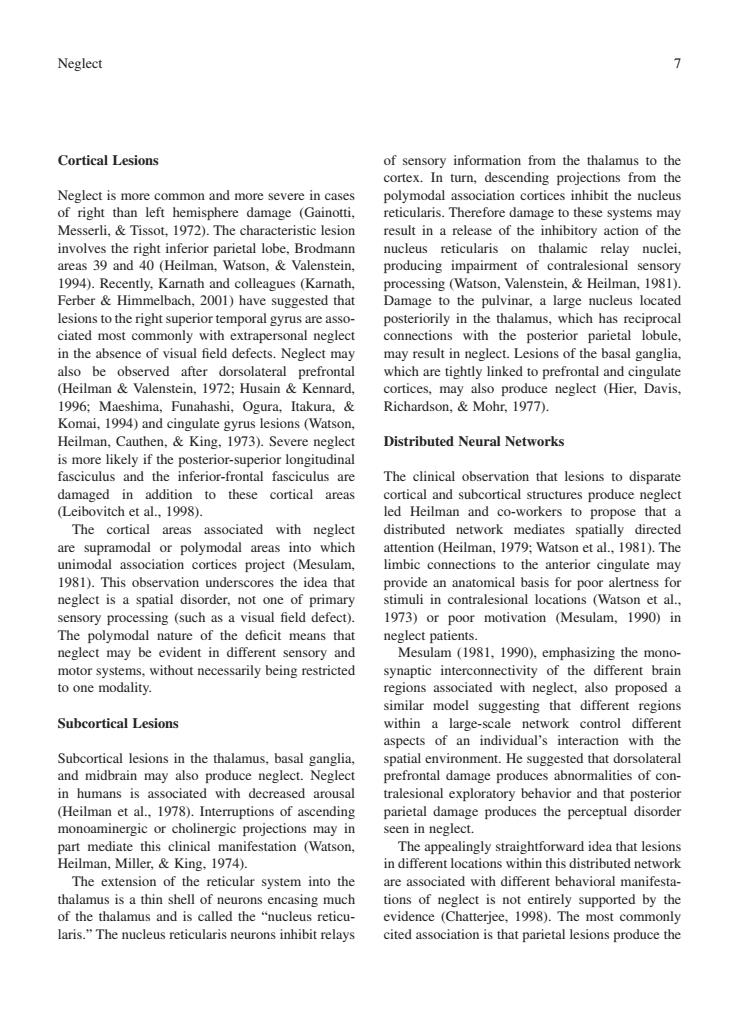正在加载图片...

Neglect 7 Cortical Lesions of sensory information from the thalamus to the cortex.In turn,descending projections from the Neglect is more common and more severe in cases polymodal association cortices inhibit the nucleus of right than left hemisphere damage (Gainotti. reticularis.Therefore damage to these systems may Messerli Tissot 1972)The characteristic lesion result in a release of the inhibitory action of the involves the right inferior parietal lobe brodmann nucleus reticularis on thalamic relay nuclei. areas 39 and 40 (Heilman.Watson.Valenstein producing impairment of contralesional sensory bint.a lg nuds loat Valenstein.Heilman.1981 Ferber&Himmelbach.2001)have suggested that are asse orily in the thalamus.which has recipr ciated most co in the absence of visual field defects.Neglect also be olateral efr (Heilman Valenstein,197:HusainKe ices neglect (Hier,Davis 1996:Maeshima Funahashi.Ogu Itak Komai.1994)and cin s (Wa Heilman.Caut en.King.1973).Se Distributed Neural Networks The ion that lesions to disparate areas 1998) and and 0 The area ated with neg distribut med spa nPoknmodal I area into wh ic n,1979 Watson et al ons to th the idea that n anato 08 for poo a spatial d not one i in ontralesional loca ons (Watson et al ory proc sing (such as visual feld defect 1973)or poor motivation (Mesulam.1990)in The polymodal nature of the deficit means that neglect patients neglect may be evident in different sensory and Mesulam (1981.1990).emphasizing the mono- motor systems,without necessarily being restricted synaptic interconnectivity of the different brain to one modality. regions associated with neglect,also proposed a similar model suggesting that different regions Subcortical Lesions within a large-scale network control different aspects of an individual's interaction with the Subcortical lesions in the thalamus,basal ganglia spatial environment.He suggested that dorsolateral and midbrain may also produce neglect.Neglect prefrontal damage produces abnormalities of con- in humans is associated with decreased arousa tralesional exploratory behavior and that posterion (Heilman et al..1978).Interruptions of ascending parietal damage produces the perceptual disorder monoaminergic or cholinergic proiections mav in seen in neglect. part mediate this clinical manifestation (Watson. The appealingly straightforward idea that lesions Heilman,Miller,King.1974). in different locations within this distributed network The extension of the reticular system into the are associated with different behavioral manifesta thalamus is a thin shell of neurons encasing much tions of neglect is not entirely supported by the of the thalamus and is called the"nucleus reticu- evidence (Chatterjee,1998).The most commonly laris."The nucleus reticularis neurons inhibit relays cited association is that parietal lesions produce theCortical Lesions Neglect is more common and more severe in cases of right than left hemisphere damage (Gainotti, Messerli, & Tissot, 1972). The characteristic lesion involves the right inferior parietal lobe, Brodmann areas 39 and 40 (Heilman, Watson, & Valenstein, 1994). Recently, Karnath and colleagues (Karnath, Ferber & Himmelbach, 2001) have suggested that lesions to the right superior temporal gyrus are associated most commonly with extrapersonal neglect in the absence of visual field defects. Neglect may also be observed after dorsolateral prefrontal (Heilman & Valenstein, 1972; Husain & Kennard, 1996; Maeshima, Funahashi, Ogura, Itakura, & Komai, 1994) and cingulate gyrus lesions (Watson, Heilman, Cauthen, & King, 1973). Severe neglect is more likely if the posterior-superior longitudinal fasciculus and the inferior-frontal fasciculus are damaged in addition to these cortical areas (Leibovitch et al., 1998). The cortical areas associated with neglect are supramodal or polymodal areas into which unimodal association cortices project (Mesulam, 1981). This observation underscores the idea that neglect is a spatial disorder, not one of primary sensory processing (such as a visual field defect). The polymodal nature of the deficit means that neglect may be evident in different sensory and motor systems, without necessarily being restricted to one modality. Subcortical Lesions Subcortical lesions in the thalamus, basal ganglia, and midbrain may also produce neglect. Neglect in humans is associated with decreased arousal (Heilman et al., 1978). Interruptions of ascending monoaminergic or cholinergic projections may in part mediate this clinical manifestation (Watson, Heilman, Miller, & King, 1974). The extension of the reticular system into the thalamus is a thin shell of neurons encasing much of the thalamus and is called the “nucleus reticularis.” The nucleus reticularis neurons inhibit relays of sensory information from the thalamus to the cortex. In turn, descending projections from the polymodal association cortices inhibit the nucleus reticularis. Therefore damage to these systems may result in a release of the inhibitory action of the nucleus reticularis on thalamic relay nuclei, producing impairment of contralesional sensory processing (Watson, Valenstein, & Heilman, 1981). Damage to the pulvinar, a large nucleus located posteriorily in the thalamus, which has reciprocal connections with the posterior parietal lobule, may result in neglect. Lesions of the basal ganglia, which are tightly linked to prefrontal and cingulate cortices, may also produce neglect (Hier, Davis, Richardson, & Mohr, 1977). Distributed Neural Networks The clinical observation that lesions to disparate cortical and subcortical structures produce neglect led Heilman and co-workers to propose that a distributed network mediates spatially directed attention (Heilman, 1979; Watson et al., 1981). The limbic connections to the anterior cingulate may provide an anatomical basis for poor alertness for stimuli in contralesional locations (Watson et al., 1973) or poor motivation (Mesulam, 1990) in neglect patients. Mesulam (1981, 1990), emphasizing the monosynaptic interconnectivity of the different brain regions associated with neglect, also proposed a similar model suggesting that different regions within a large-scale network control different aspects of an individual’s interaction with the spatial environment. He suggested that dorsolateral prefrontal damage produces abnormalities of contralesional exploratory behavior and that posterior parietal damage produces the perceptual disorder seen in neglect. The appealingly straightforward idea that lesions in different locations within this distributed network are associated with different behavioral manifestations of neglect is not entirely supported by the evidence (Chatterjee, 1998). The most commonly cited association is that parietal lesions produce the Neglect 7